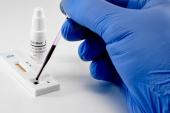Watch Out for Differences Among High-Sensitivity Troponin Assays
Discrepancies in benchmarks can affect decision-making, especially when patients are transferred between centers.

The three high-sensitivity cardiac troponin (hs-cTn) assays currently available in the United States often disagree when it comes to standard analytical benchmarks, which could have an impact on how patients with suspected ACS are managed, a study shows.
Only 37.4% of blood samples collected as part of the ROMICAT I and II trials were placed into the same analytical category by US Food and Drug Administration-approved assays from Abbott, Roche, and Siemens, researchers led by Júlia Karády, MD (Massachusetts General Hospital, Boston, and Semmelweis University, Budapest, Hungary), report.
Concordance was only 11.1% when determining whether the troponin level was below the limit of detection (LOD), 29.3% for whether it was between the LOD and the 99th percentile, and 43.6% for whether it was above the 99th percentile.
Moreover, among patients with serial measurements, management decisions based on troponin levels agreed across all three assays in about three-quarters of cases. Concordance ranged from a high of 74.7% for ruling out ACS to a low of just 15.7% for observation, with 38.5% agreement when it came to ruling in ACS.
Karády said these differences across assays are particularly relevant when a patient is being moved from one center to another—after being triaged at one hospital and transferred to another for an intervention, for instance. “In case these hospitals have different assay types, probably the receiving center needs to reassess the clinical background and maybe add further noninvasive diagnostic testing just to be sure that the troponin findings are treated appropriately,” she suggested.
Until a definitive method for resolving differences across assays is agreed upon, Karády is calling for “general awareness that assays may differ and therefore the clinical decisions delivered by each assay could be different. So this should be taken into account when someone makes a clinical decision.”
Substantial Differences in Patient Care Possible
For the study, published in the March 30, 2021, issue of the Journal of the American College of Cardiology, the investigators assessed how three high-sensitivity troponin assays available to US clinicians—the Elecsys 2010 platform (Roche Diagnostics), ARCHITECT i2000SR (Abbott Diagnostics), and the precommercial HsVista (Siemens Diagnostics)—performed using blood samples obtained from the ROMICAT I and II trials, which enrolled patients with suspected ACS who were referred for further noninvasive diagnostic testing after an inconclusive triage in the emergency department.
The analysis included 1,027 samples taken from 624 patients (mean age 52.8 years; 39.4%); 7.9% ultimately received an adjudicated diagnosis of ACS.
When looking at analytical benchmarks across assays, there was a significant difference in the proportion of samples with troponin below the LOD—56.3% for Roche, 10.4% for Abbott, and 41.2% for Siemens (P < 0.001). A similar discrepancy was seen for levels between the LOD and the 99th percentile—36.5% for Roche, 83.5% for Abbott, and 52.6% for Siemens (P < 0.001).
There was no significant difference across assays for troponin levels above the 99th percentile—7.2% of samples for Roche, 6.0% for Abbott, and 6.2% for Siemens (P = 0.114).
The was disagreement among the tests when using sex-specific thresholds as well, with some differences emerging between men and women. When assessing levels above the 99th percentile, the assays agreed in men, but not in women.
An analysis looking at how well triage decisions made on the basis of the test results agreed across assays focused on the 242 patients with serial samples and showed better concordance (74.8% overall) than was seen for the analytical benchmarks. However, the proportions of patients who had ACS ruled out and who were selected for further observation differed significantly across assays (P < 0.001 for both). The percentage of patients ruled in for an ACS diagnosis was similar with all three tests—3.3% for Roche, 2.9% for Abbott, and 3.7% for Siemens (P = 0.687).
The discrepancies between tests “may translate into substantial differences in patient care between hospitals,” Karády et al write. “For example, by using a troponin-I assay (Abbott or Siemens) the rate of those who cannot be discharged or can be admitted is approximately double compared with Roche (24.0% and 17.8% vs 9.5%), leading to an almost twofold difference between these assays. It is not surprising, thus, that we observed the poorest agreement within observed management strata with 15.7% concordance among all three assays.”
Another interesting finding, Karády noted, was that among the patients with a troponin measurement below the LOD, roughly 20% had either obstructive CAD or inducible ischemia on noninvasive imaging. “Because [of] the known short-term (30-day) and long-term prognostic significance of obstructive CAD and inducible myocardial ischemia, it is important to take into account the degree of underlying disease potentially unrecognized via hs-cTn testing,” she and her colleagues write.
A Universal Reference Population?
The investigators point out that all three assays have been reported to have excellent diagnostic performance, so it’s more likely that the discrepancies observed in this study are reflective of differences in the reference populations used to determine various cutoffs.
“It is known that age and gender distribution of reference populations could impact substantially the upper LOD of a healthy population,” they write. “Therefore, potential solutions include endorsement of thresholds (99th percentile) derived with the use of a standardized reference population for all hs-cTn platforms or methods to express likelihood for ACS in a probabilistic fashion.”
They added that it remains unclear, however, “whether a single reference cohort is sufficient to ensure generalizability across age, sex, and race, or whether unique 99th percentile definitions are required with multiple reference cohorts.”
In an accompanying editorial, Joseph Alpert, MD (University of Arizona College of Medicine, Tucson, AZ), and colleagues highlight use of a universal reference population as a potential solution for the differences seen in the study.
“These hurdles underscore the need for the development of better algorithms for hs-cTn assay interpretation in clinical practice, including reconsideration of currently used 99th percentile upper reference limits based on the manufacturer’s individual reference populations in favor of using a standardized reference population for all hs-cTn platforms,” they write.
Echoing Karády, Alpert et al say one of the take-home messages is to “‘let the buyer (ie, the clinician) beware’ when patients are transferred from one hospital to another, where different hs-cTn assays may be used at the two institutions. In such cases, careful clinical review and possibly additional diagnostic testing might be indicated.”
Also noteworthy is that “important differences between the sexes affect hs-cTn management decisions,” they write. “Women have lower normal measurements, so a small increase in values that might be considered a normal variation in a male patient might have significance in a female patient. This is particularly relevant for the ‘observe (gray zone)’ hs-cTn values.”
And finally, they agree “that clinicians should be aware of the discordances among commercially available hs-cTn assays when stratifying patients with suspected acute MI. Such disparities may result in different management recommendations.”
Todd Neale is the Associate News Editor for TCTMD and a Senior Medical Journalist. He got his start in journalism at …
Read Full BioSources
Karády J, Mayrhofer T, Ferencik M, et al. Discordance of high-sensitivity troponin assays in patients with suspected acute coronary syndromes. J Am Coll Cardiol. 2021;77:1487-1499.
Alpert JS, Jaffe A, Thygesen KA. Let the buyer (clinician) beware. J Am Coll Cardiol. 2021;77:1500-1502.
Disclosures
- Karády reports having received support from the Fulbright Visiting Researcher Grant and the Rosztoczy Foundation.
- Alpert reports no relevant conflicts of interest.




Comments